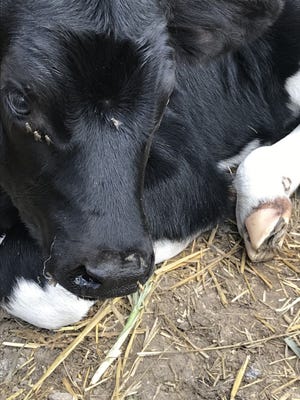How to manage and prevent summer pink eye in cattle

Pink eye is a common problem for cattle during the summer, but that doesn't mean you can't treat it. It's important to remove eye irritants like face flies in order to keep your cattle healthy and safe.
Sandy Stuttgen, an ag educator for the University of Wisconsin-Madison extension, says the first signs of eye irritation are tearing, tear stains and squinting, which get progressively worse as pink eye continues to develop. Pink eye may also appear as an opaque spot on the cornea. Conjunctivitis and corneal ulceration may also occur, she writes.
Under normal circumstances, eyes can prevent infection on their own, but when irritation happens, pathogens can enter the eyes and cause pink eye, Stuttgen says. Physical trauma is one of the most common causes of this, as a result of things like aggression, bumping into self-feeders, rough handling or abrasive bedding. Dust, sand, face flies, bright sunlight and chemicals can also cause irritation.
Pink eye can usually resolve itself as the spontaneous recovery rate is at 98%, with just 2 in every 100 animals losing sight, Stuttgen writes. Other times it can result in cornea damage and blindness, making it very difficult and expensive to treat if the eyes are left infected for too long. Herds also spread the infection much more quickly with an average 44% herd prevalence rate, she writes.
Veterinarians agree that quarantining infected animals away from the herd and in a dark area away from sunlight is the best course of action to avoid further spread. You can also suture the eyelids and apply eye patches to speed up recovery. Antibiotic treatments vary wildly in outcome and may even further spread disease, Stuttgen says. Even after initial recovery, there may be lasting damage in the cornea.
You should work with your veterinarian to determine a booster vaccination schedule for your cattle, Stuttgen says. Since there are two primary strains of pink eye, two different vaccinations are needed, since one will not protect against the other. Requirements for vaccines differ depending on age, dosage and the general makeup of the herd, she says. All vaccinations should be given several weeks ahead of the summer season to allow time to develop immunity.

Pink eye can also make your cattle less likely to eat and drink because of pain and inability to find food and water, and it can also reduce their market value. Young cattle are more susceptible to pink eye than older cattle. Mineral deficiencies also seem to go hand in hand with recurrent pink eye outbreaks, Stuttgen says.
Face flies are also proven to have an economic and health impact on cattle. Stuttgen writes that 12-14 flies can decrease grazing time by one hour, and anywhere from 20 to 200 flies can be considered a heavy population creating irritation to the eyes. Flies may feed on the eyes, increasing eye tissue damage and transmitting diseases, Stuttgen says. They may also feed on nose secretions, transmitting diseases that way. They thrive in bright, warm sunlight and lay their eggs in fresh manure.
Stuttgen says that face flies can be controlled by regularly applying insecticides to the cow's face and fresh manure throughout the season. You can also apply oral insecticides to feed, or use organophosphate or permethrin sprays as face fly repellent. Dust bags and oilers can be hung where cattle can rub their heads against them, like at waterers, on doorways and along a feeder wagon. While most tags are used for horn flies, some can also be used for face flies – one per ear for adults or one total for calves, Stuttgen writes.